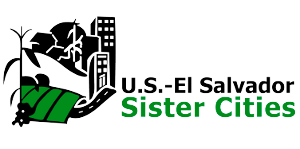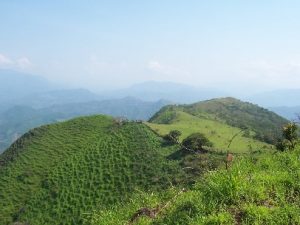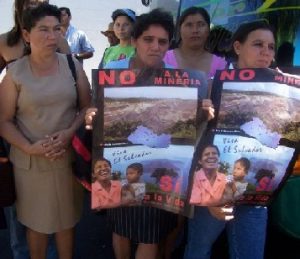Sister Cities
Gold Mining Analysis and Resistance Series #2, October 2008
Educating Our Communities Against Propaganda, South and North
October, 2008
Education in Chalatenango
When the first representatives of the mining companies arrived in Chalatenango, the communities urgently began to educate themselves about this new threat. Those educational efforts began three years ago and have continued uninterrupted ever since. Early experiences included community leaders visiting communities affected by mining in neighboring Guatemala. They came back and shared what they leaned about the disastrous effects on the environment and health and violence perpetrated against the local population. They sought out technical information about the mining process and the consequences specific to El Salvador. They organized workshops and multiplied the information through presentations throughout the region.
The threat of mining and the consequences is a theme touched upon in community assemblies, in workshops and meetings, it is the focus of popular theater presentations, it is talked about and analyzed on the street, at mass, and on the radio. Rosa Dubón of the community radio station Radio Sumpul explains, “We used to talk a lot about the consequences of mining. But now that we know the consequences, we don’t need to discuss it as much.” Instead there is more of a focus on maintaining a campaign of information and analysis, so that no one is deceived by the mining companies’ propaganda and offers of “development”.
Education is among the most important tools the communities have in resisting the threat posed by mining, providing information and resources about the true consequences of mining before the mining companies were able to arrive with their lies and deceptive and divisive tactics. Through education campaigns, the communities were able to organize and unite against this threat.
Canadian Haven for Mining Investment
Education is equally important in the US and Canada, where most of the world’s mining companies are based. Eighty percent of global mining financing is done through the Toronto Stock Exchange (TSX), and 60% of the world’s mining companies are registered in Canada[1]. This is because for decades, Canadian law that regulates mining companies and that regulates investment in mining has created a “haven” for mining companies analogous to Switzerland or Bermuda as a haven for off-shore banks.
For example, Canadian investment law allows companies to sell shares based on “mineral reserves” (mineral still in the ground, which a company does not necessarily have legal access to nor the means to extract)[2]. Companies like Pacific Rim raise the money they spend on overseas exploration through the sale of stock – some of it representing gold they don’t yet have access to extract, but that investors are willing to gamble on and that Canadian law allows them to do. This money is spent not just on geologic and mineral testing, but on what companies call “gaining social license” – actions which, in communities that oppose mining for very good reasons, take the form of bribery, manipulation, and propaganda.
Mining Company Strategies
The strategies mining companies take to gain “social license” are far from incidental. Mining companies carefully study opposition to their projects, and hire consultants who orchestrate strategies to stop, discredit, or co-opt it. These consultants detail, for example, how companies can create a “Community Advisory Panel” to validate their interests: “Find three to four people from the community who want to work with you to make you successful. Use that core of members to draft the terms of agreement and to recruit the members.”[3] Consultants also advise mining companies to offer corporate sponsorships for NGOs and community organizations: “Identify key opposition groups and the individuals within them who are likely to be more supportive/less opposed to [the company],”[4] they advise.
One of the main strategies that the mining lobby has taken in El Salvador is to promote “innovative new green mining”. “Green” is a hard word for the Salvadoran communities to believe when the mining in question involves the elimination of agricultural land, the extraction of gold from ore with cyanide, the demolition of Chalatenango’s mountains, and the contamination of the fresh water sources they contain.
Despite these efforts by the company, the people of northern El Salvador are not being fooled. As we educate ourselves and organize North and South, the message painted on banners and murals in Chalatenango and Cabanas is clear: “No a la minería, sí a la vida : Life, not Mining.”

[1] The Dominion, Issue #55, 2008, page 21. www.dominionpaper.ca.
[2] The Dominion, Issue #55, 2008, page 21. www.dominionpaper.ca.
[3] Geoff Evans, James Goodman and Nina Lansbury (editors), Moving Mountains: Communities Confront Mining and Globalisation, Contemporary Otford Press/Mineral Policy Institute (MPI), Sydney 2001.
[4] Geoff Evans, James Goodman and Nina Lansbury (editors), Moving Mountains: Communities Confront Mining and Globalisation, Contemporary Otford Press/Mineral Policy Institute (MPI), Sydney 2001.


